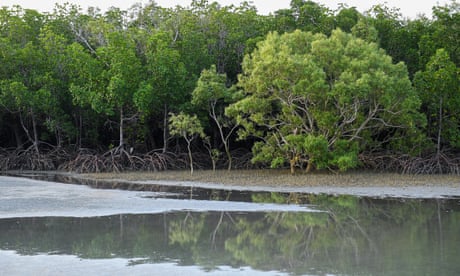- by foxnews
- 08 Apr 2025
‘Wobbly’ moon probable cause of mass tree deaths in Australia, scientists say
‘Wobbly’ moon probable cause of mass tree deaths in Australia, scientists say
- by theguardian
- 15 Sep 2022
- in news

A wobble in the moon's orbit around Earth affects mangrove cover across Australia and likely contributed to mass tree deaths in the Gulf of Carpentaria, new research suggests.
A study published in the journal Science Advances has found that an 18.61-year cycle known as the lunar nodal cycle shapes the condition of tidal wetlands.
The moon's orbit around Earth does not occur in a flat plane. "Since the 1720s, people have known that it moves up and down by a few degrees," said the study's lead author, Prof Neil Saintilan of Macquarie University. He likened the motion to "when you're spinning a coin - as it loses momentum, it kind of wobbles".
Changes in gravitational pull as a result of this lunar wobble are known to affect the Earth's tides. Previous research conducted by Nasa scientists has predicted that in the mid-2030s, the lunar wobble will amplify rising sea levels caused by climate change, resulting in high-tide floods along coastlines.
Depending on the phase of the lunar nodal cycle, there can be "as much as 40cm of difference in the tide range" in places such as the Gulf of Carpentaria, Saintilan said.
Mangroves "grow between the average high-tide level and the highest high-tide levels", he said. At lower tidal ranges, mangroves are inundated less frequently. "When they're stressed, because they lose water through their leaves, they just drop their leaves."
The scientists used historical satellite imaging to quantify the extent of mangrove cover across Australia every year between 1987 and 2020. The oscillation in canopy cover was "immediately obvious when you graph the data", Saintilan said.
Along the Arnhem coast in the Northern Territory and the Carnarvon coast in Western Australia, the researchers found that peaks in closed canopy cover - where thickened mangrove canopy covered more than 80% of ground area - coincided with the peak tidal phases of the moon's wobble.
A quirk of the lunar wobble is that it has the opposite tidal effects along coastlines which have one high tide daily compared to those that have two high tides daily.
In a region with only one daily high tide, a phase of the lunar cycle may result in a lower tidal range and less frequent water inundations. The same phase will have the inverse effect along coastlines with two daily high tides, resulting in more mangrove inundation.
Dr Brad Tucker, an astrophysicist at the Australian National University, who was not associated with the study, likened the lunar wobble to the vertical bobbing of an object in water. "It does this bobbing up and down every 18.6 years," he said. "If the moon is further up or down in relation to Earth, that's going to change the gravitational pull."
Another factor affecting tidal activity on Earth is that "the moon is not a perfect circle when it orbits," Tucker said. "It varies in its perigee and apogee - how close and far away it is."
These gravitational effects were independent of the brightness phase of the moon, Tucker said.
- by foxnews
- descember 09, 2016
Ancient settlement reveals remains of 1,800-year-old dog, baffling experts: 'Preserved quite well'
Archaeologists have recently unearthed the remarkably well-preserved remains of a dog from ancient Rome, shedding light on the widespread practice of ritual sacrifice in antiquity.
read more


